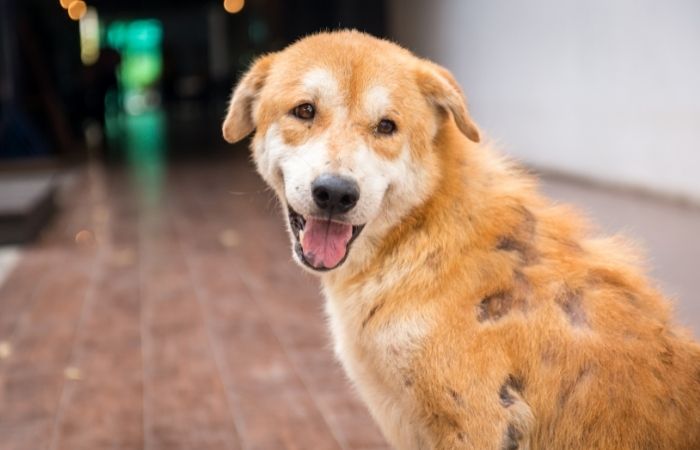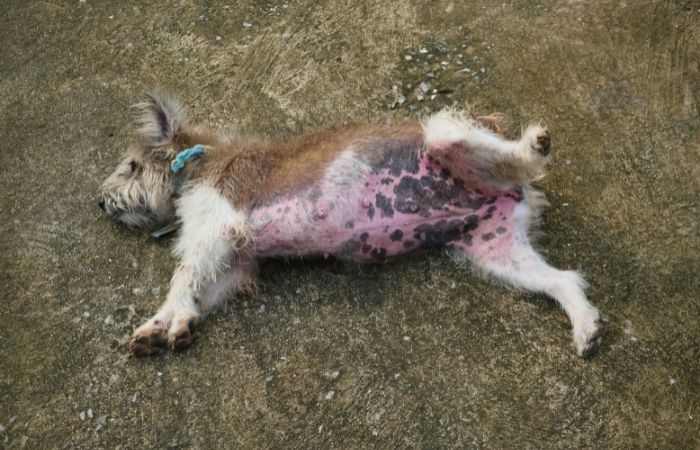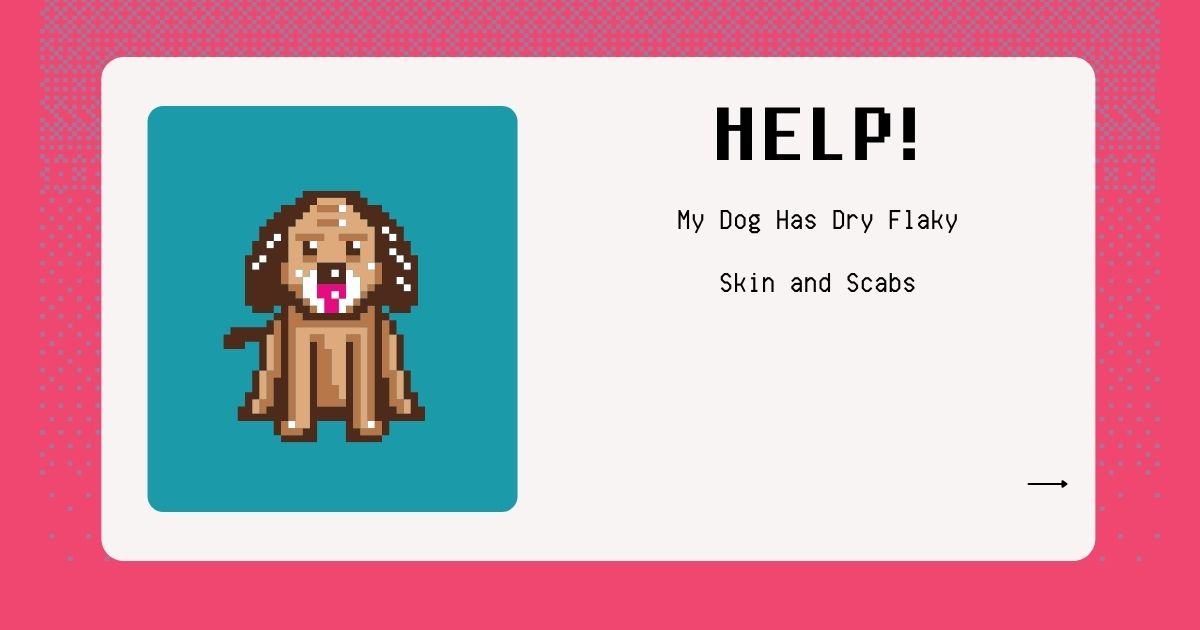My dog has dry flaky skin and scabs! What should I do? Dogs are known to be man’s best friend. They are loyal, loving, and fun to play with. However, if your dog has dry, flaky skin or scabs, it can be very frustrating. You want the best for your pet but don’t know how to help them out when they have these problems.

Well, look no further because we have some great tips that will help your pup get rid of his pain.
Skin Infections in Dogs
Dogs and puppies can develop skin infections just like humans. This is because they do not have as much protection from germs as we do. When they get sick, their immune system works double-time to protect them. The production of white blood cells increases, which causes the skin to become irritated, causing dry, flaky skin and scabs.
Skin infections in dogs can be caused by bacteria, fungus, mites, or yeast. Depending on the type, your dog might develop bumps or blisters all over its body. You might also notice your dog losing hair in patches and scabs, and it often stinks.
What is the Difference Between a Hotspot and Ringworm in Dogs?
A hotspot is a type of skin infection in dogs. It is also sometimes referred to as acute moist dermatitis. A hotspot looks like a red bumpy rash but can also have little bumps on it. Sometimes it even has a bit of pus in the middle. A hotspot is more likely to be caused by allergies.
Ringworm, on the other hand, is a type of fungus. It looks like a circle of little bald spots where the hair falls out. If your dog gets ringworm, you will need to take it to the vet to give them some medication.
Both of these infections are contagious in dogs, but it is more difficult for them to catch ringworm from other dogs. Your dog might be more susceptible if it has a compromised immune system or is very young or old.
Dogs with dry, flaky skin may also have hotspots and ringworms on their skin. They might look different, though; sometimes, they look like scabs that are crusty and raised. If your dog has any of these skin infections, you should talk to your vet or groomer so they can get rid of them ASAP!
Common Treatment Options for Dog Allergies
There are many options for treating your dog if they have allergies.
Below are some treatment strategies
Flea allergies: If your dog has flea allergies, you will likely have to give him a bath with a special dog shampoo. You can find these shampoos in your local stores or online if you are shopping for other pet supplies. Allergic reactions can be caused by fungus, mites, or yeast infections.
Fungal, Mite, or Yeast Infections in Dogs: Your vet can also prescribe you some antibiotics for dogs if your pup has a yeast infection or mites. You can also buy supplements for dogs that have ringworm. These supplements will help treat the rash and relieve dog skin irritation after a few days.
Food allergy: If your dog has food allergies, you’ll need to switch to a hypoallergenic dog food diet. The most hypoallergenic food for dogs is a commercially prepared diet based on hydrolyzed protein.
Corticosteroids: Corticosteroids can be used to reduce inflammation and relieve symptoms. They come as creams, lotions, oral pills, or injections. In high-risk cases, such as where the dog has severe skin lesions or is scratching excessively, corticosteroids might be used on an ongoing basis.
Environmental allergies: Long-term management of your dog’s allergies will require some effort on your part. You may need to change your pet’s environment, the activities you enjoy with your pet, and your lifestyle.
However, there is another dog dry, flaky skin and scabs home remedy:
Bathe your pet weekly with a hypoallergenic shampoo and use a conditioner specially formulated for dogs. Avoid using human shampoos or dishwashing liquids, which can cause skin irritation and worsen the allergy.
You can also use antihistamines such as Benadryl–vets highly suggest it. You can get Benadryl at any pharmacy, and it is very cheap! Also, there are chewable tablets for dogs, so if you need to give this to your pup, you can just put it in their mouth, and they will swallow it.
How to Treat Flaky Skin and Crusty Scabs in Dogs
There are several dog rash treatments and remedies that you can try to help your dog’s dry, flaky skin and scabs.

The first thing you should do is take it to the vet and find out what is causing the dog’s skin condition to be treated as quickly as possible. If it is allergies, the vet will prescribe medication like Benadryl or something for it to take.
You should also make sure that you are not feeding them any food that might be causing the allergy. For example, sometimes dogs develop allergies when they eat too many table scraps or when their food doesn’t have the right ingredients.
You will also want to bathe them regularly, but don’t use just any kind of shampoo! Look for one that is made specifically for dry, flaky skin or that is allergy-free. Your vet may recommend something to you.
If parasites like fleas or ticks cause bumps on dogs’ skin, you will need to bathe your dog with a special shampoo that will help get rid of them. You should also keep it away from other dogs in the household or public places because it could pick up another parasite if it comes into contact with them.
Finally, for some dogs, the problem may be hot weather. If your dog has dry, flaky skin and scabs in the summer and warm climates, it needs to stay inside in a cool area where it is not so hot. If you can’t keep your dog inside, then at least make sure you take it out to play or walk in the early morning or later at night when it is cooler outside.
How to Prevent Scabs in Dogs Caused by Dry Skin
If you want to keep your dog from getting scabs again in the future, then there are some precautions that you will need to take.
- The first thing you will need to do is to get rid of any parasites. This can be done by getting medication or spot-on treatments from your vet or bathing it with anti-parasite shampoo.
- Finally, make sure that you are keeping their skin moisturized. You can do this with a good quality lotion or by bathing them in warm water.
The Causes of Crusty Scabs on Dogs
Some of the causes of dry, flaky skin and crusty scabs in dogs are allergies, parasites, hot weather, and malnutrition.
Allergies
If your dog has allergies, then they can cause his skin to become dry and itchy. Scabs may also form if he continues to scratch the irritated skin.
Parasites
In some cases, your dog could get a parasite from another dog or from coming into contact with ticks or fleas. If that is the case, it will need to take unique treatments or baths to get rid of them.
Hot Weather
Your dog may also develop skin problems when the weather is warmer. For example, if it is outside in the summer and is very hot, their skin may become dry, flaky, and scabby. Or if it becomes very humid, then the skin on its body will become moist and crusty.
Malnutrition
If your guard dog is not getting enough vitamins or nutrients in his diet, it will need to take supplements. Vitamin deficiencies can also cause scabs to form on your dog’s skin, as well as on the skin of other animals.
What are Crusty Scabs, and What do They Look Like?
A crusty scab is a dry, thickened patch of skin that forms when the top layer of skin has been injured. It looks like a yellow or brown flaky area on the skin.
They are often the result of a dog’s skin being injured by biting, scratching, or chewing. If your dog has developed crusty scabs on its skin, then you will need to take it to the vet for treatment.
Types of Dog Crusty Scabs
Two types of crusty scabs can appear on your dog’s skin.
- The first type of crusty scab is caused by your dog biting, scratching, or chewing at their skin because of allergies. These are commonly referred to as hot spots.
- The second type of crusty scab is caused by your dog’s skin being injured by biting, scratching, or chewing at it.
These scabs can be very red and irritated because bacteria have entered the skin through the open wound and are multiplying rapidly.
Common Places on Dogs Where Crusty Scabs Appear
Crusty scabs commonly appear on parts of the dog’s body that are constantly bitten, scratched, or chewed. These include areas of thick, furred skin that are hard to keep clean.
Your dog may develop scabs on its body if it constantly scratches itself or parasites are always biting it. Crusty scabs are also common in dogs with itchy skin issues, dry skin, or allergies.
How to Find Crusty Scabs on Your Dog
Finding crusty scabs on your dog can be easy, or it can be difficult, depending on where the scabs are. First, try taking a close look at the areas of your dog’s body that it constantly bites, scratches, or chews.
Crusty scabs can appear on any part of your dog’s body, but there are certain places you should look. When you groom or bathe your dog, you will want to check its face and ears for any signs of crusty scabs.
You should also look behind the dog’s ears, the front of the legs and paws, along the back, and check for a red rash on the dog’s belly and around its neck. The scabs may appear as red or black spots on dogs’ skin that look crusted over.
Final Thoughts
As you can see, crusty scabs on dogs are typical dog skin conditions that are relatively easy to spot. They are also reasonably easy to treat with antifungal creams.
If your dog seems to have red, constantly irritated skin and crusty scabs that are moist or filled with pus, it may have a more severe dog skin infection that needs to be checked by the vet.


2 thoughts on “HELP! My Dog Has Dry Flaky Skin and Scabs”
Comments are closed.